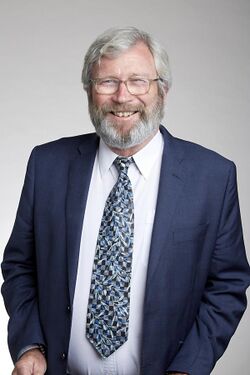Biography:Gerard J. Milburn
Gerard Milburn | |
|---|---|
 Gerard Milburn at the Royal Society admissions day in London, July 2017 | |
| Born | Gerard James Milburn 1958 (age 65–66) Brisbane, Queensland, Australia |
| Nationality | Australian |
| Alma mater |
|
| Known for | |
| Scientific career | |
| Fields | Physicist |
| Institutions |
|
| Doctoral students | Howard M. Wiseman[1] |
| Website | smp |
Gerard James Milburn (born 1958) is an Australian theoretical quantum physicist notable for his work on quantum feedback control, quantum measurements, quantum information, open quantum systems, and Linear optical quantum computing (aka the Knill, Laflamme and Milburn scheme).[2][3][4][5][6]
Education
Milburn received his BSc (Hons) in Physics from Griffith University in 1980. He completed his PhD in physics under Daniel Frank Walls[7] at the University of Waikato in 1982, with a thesis entitled Squeezed States and Quantum Nondemolition Measurements.[citation needed]
Career and Research
Following his PhD, Milburn did postdoctoral research in the Department of Mathematics at Imperial College London in 1983.[citation needed] Later, in 1984, he was awarded a Royal Society Fellowship to work in the Quantum Optics group of Peter Knight,[7] at Imperial.[citation needed]
In 1985 he returned to Australia and was appointed lecturer at The Australian National University. In 1988 Milburn took up an appointment as Reader in Theoretical Physics at The University of Queensland. In 1994 he was appointed as Professor of Physics and in 1996 became Head of Department of Physics at The University of Queensland. From 2000 to 2010 he was Deputy Director of the Australian Research Council Centre of Excellence for Quantum Computer Technology. From 2003 to 2013 he was an Australian Research Council Federation Fellow at the University of Queensland.
He was the Chair of the Scientific Advisory Committee of the Institute for Quantum Computing and served on the scientific advisory committee for the Perimeter Institute for Theoretical Physics from 2007 to 2010.[citation needed]
From 2011 to 2017 he was the Director and Chief Investigator of the Australian Research Council Centre of Excellence for Engineered Quantum Systems.[8]
Honors and awards
His awards include the Moyal Medal for Mathematical Physics (awarded 2001[9]) and Boas medal, (awarded in 2003). He is a fellow of the Australian Academy of Science (1999), a Fellow of the American Physical Society (2005), and elected a Fellow of the Royal Society in 2017.[10]
References
- ↑ Gerard J. Milburn at the Mathematics Genealogy Project
- ↑ "Schroedinger's Machines", (W. H. Freeman, 1997)
- ↑ "The Feynman Processor", (Allen and Unwin, 1998)
- ↑ D. F. Walls and G. J. Milburn Quantum Optics (Springer, 1994)
- ↑ Wiseman, Howard M.; Milburn, Gerard J. (2009). Quantum Measurement and Control. Cambridge; New York City: Cambridge University Press. pp. 460. ISBN 978-0-521-80442-4. https://archive.org/details/quantummeasureme00wise.
- ↑ An interview with Gerard J. Milburn
- ↑ 7.0 7.1 Cite error: Invalid
<ref>tag; no text was provided for refs namedrsbm - ↑ "Overview | ARC Centre of Excellence for Engineered Quantum Systems". equs.org. http://equs.org/overview.
- ↑ "Moyal Medallists – Department of Mathematics". maths.mq.edu.au. https://maths.mq.edu.au/moyal-medal/medallists/.
- ↑ Anon (2017). "Gerard Milburn". royalsociety.org. https://royalsociety.org/people/gerard-milburn-13405/.
 |

